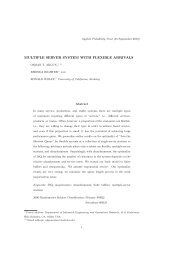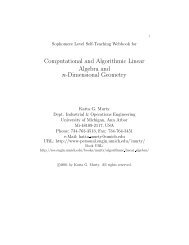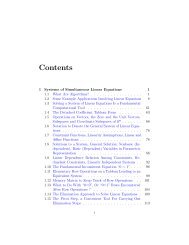Chapter 1 LINEAR COMPLEMENTARITY PROBLEM, ITS ...
Chapter 1 LINEAR COMPLEMENTARITY PROBLEM, ITS ...
Chapter 1 LINEAR COMPLEMENTARITY PROBLEM, ITS ...
Create successful ePaper yourself
Turn your PDF publications into a flip-book with our unique Google optimized e-Paper software.
14 <strong>Chapter</strong> 1. Linear Complementarity Problem, Its Geometry, and Applications<br />
where a 0<br />
ij = aij ; (arjais)=ars, fori = r +1tom, j =1ton. As an example consider<br />
the Gaussian pivot step in the following matrix with row 2 as the pivot row and column<br />
3 as the pivot column. The pivot element is inside a box.<br />
8<br />
>:<br />
1 ;2 10 ;4 ;1<br />
4 6 2 ;8 ;4<br />
;3 1 ; 1 2 3<br />
1 ;4 2 3 0<br />
This Gaussian pivot step transforms this matrix into<br />
8<br />
>:<br />
1 ; 2 10 ; 4 ;1<br />
4 6 2 ; 8 ;4<br />
;1 4 0 ; 2 1<br />
;3 ;10 0 11 4<br />
Result 1.8 Let D be a square symmetric matrix of order n > = 2. Suppose D is PD.<br />
Subtract suitable multiples of row 1fromeach of the other rows so that all the entries<br />
in column 1 except the rst is transformed into zero. That is, transform<br />
D =<br />
2<br />
6<br />
4<br />
d11 ::: d1n<br />
d21 ::: d2n<br />
.<br />
.<br />
dn1 ::: dnn<br />
3<br />
7<br />
5 into D1 =<br />
2<br />
6<br />
4<br />
9<br />
><br />
9<br />
><br />
d11 ::: d1n<br />
0 d22<br />
~ ::: d2n<br />
~<br />
.<br />
.<br />
.<br />
0 dn2<br />
~ ::: dnn<br />
~<br />
by a Gaussian pivot step with row 1 as pivot row and column 1 as pivot column, clearly<br />
~dij = dij ; d1jdi1=d11 for all i j > = 2. E1, the matrix obtained by striking o the rst<br />
row and the rst column from D1, isalso symmetric and PD.<br />
Also, if D is an arbitrary square symmetric matrix, it is PD i d11 > 0 and the<br />
matrix E1 obtained as above is PD.<br />
Proof. Since D is symmetric dij = dji for all i j. Therefore,<br />
y T Dy =<br />
nX<br />
nX<br />
i=1 j=1<br />
= d11 y1 +<br />
yiyjdij = d11y 2 1 +2y1<br />
nX<br />
j=2<br />
d1jyj =d11<br />
2<br />
nX<br />
j=2<br />
+ X<br />
ij> = 2<br />
d1jyj + X<br />
ij> = 2<br />
yi ~ dijyj :<br />
3<br />
7<br />
5<br />
yiyjdij<br />
Letting y1 = ;( P n<br />
j=2 d1jyj)=d11, weverify that if D is PD, then P ij> = 2 yi ~ dijyj > 0 for<br />
all (y2:::yn) 6= 0,which implies that E1 is PD. The fact that E1 is also symmetric<br />
is clear since ~ dij = dij ; d1jdi1=d11 = ~ dji by the symmetry of D. If D is an arbitrary<br />
symmetric matrix, the above equation clearly implies that D is PD i d11 > 0 and E1<br />
is PD.










